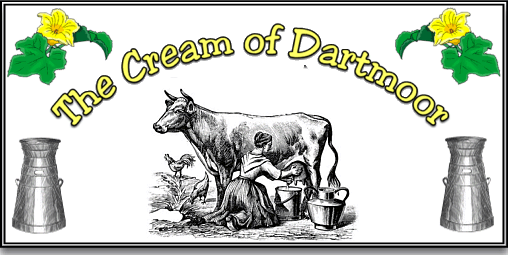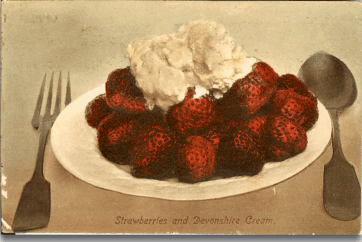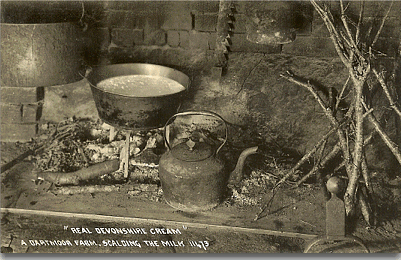
“Sweeter than the odours borne on southern gales,
Comes the clotted nectar of my native vales –
Crimped and golden crusted, rich beyond compare,
Food on which a goddess evermore would fare.
Burns may praise his haggis, Horace sing of wine,
Hunt his Hybla-honey, which he deem’d divine,
But in the Elysium’s of the poet’s dream
Where is the delicious without Devon-cream… ?“
Edward Capern.
There has always been a great rivalry between Devon and Cornwall and the debate to who produces the best clotted cream is one of the fiercest topics of debate. One writer once tactfully suggested that, “there is nothing better than Devonshire cream when tasted in Devon and equally the Cornish cream is best when eaten in Cornwall”. Forget, Devon and Cornwall there is nothing better than Dartmoor cream no matter where it is consumed!
But where did this delight come from? Well one suggestion would be the following story: Many, many years ago when witches and warlocks spun their magical spells there was a beautiful, young princess who lived in the uppermost branches of a huge, old oak tree. From her leafy bower she could see right across the moors and down to the sea and would spend her days sadly gazing out across the rocky tors. The reason for her unhappiness was that she had fallen in love with an elfin prince and the couple wanted to get married. But amongst the roots of the seasoned oak lived a snaggle-toothed old crone who had decided that the princess was to marry her son. He was an unearthly creature who dwelt in a dark cave where he smelted tin brought to him by the ‘nuggies’. This meant that until the princess could marry the prince she could not descend from her oaken prison because as soon as she did the wicked old witch would have caught her and taken her off to be married to the ugly son. To complicate matters even further, when piskie royalty got married, it was always the custom that before her wedding, the bride was bathed in milk and the purest of cream. The old witch new of this and every time the piskies made the cream she would cast a spell that turned it sour. So, no pure cream, no wedding and despite the dogged efforts of the piskies to make the cream, every batch was ruined.
Then one day in late spring the piskie prince appeared at the bottom of the tree, in his hand was a pail of milk and a huge crystal bowl of clotted cream. This special type of cream had been made with fire and water which meant no matter what spells the old witch conjured up they could not sour the cream. The princess bathed in the milk and anointed herself with the cream and then descended from the tree to her awaiting prince.
To mark this happy occasion the prince sent a party of piskies to teach all the ‘maids of the moor’ the secrets of making clotted cream. That secret has been passed down from mother to daughter ever since and it is that to make the cream rise it first needed water to cover the bottom of the pan and fire to heat it – fire and water. That is why the Dartmoor Clotted Cream is the best, it was a gift from the piskies. Shortly after this the young wife of the ‘Giant of Dinger Tor‘ learned the secret of how to combine clotted cream with scones and jam to make the perfect cream tea.

Well ok, putting the piskies aside for a moment, clotted or ‘clouted’ cream has been produced on Dartmoor farms for centuries. It is thought that the term ‘clouted’ derived it appearance and texture being similar to cloth or clout. Until around the mid 1900’s the majority of the milk produced on the moor farms went to butter and cream making with the remainder going for household delivery. The task of making the butter and cream always fell upon the shoulders of either the maids or the farmer’s wife. In 1796, Marshall describes how the clotted cream was made. The actual method was to stand the fresh milk in brass or earthenware pans or ‘crocks’ overnight. This would allow the cream to ‘rise’ which was then ‘scalded’ to a temperature just below boiling point. It was imperative not to let the cream boil because if it did the cream would be spoil or in Marshall’s words, “the smallest degree of ebullition mars the process”. It was generally considered that the correct temperature had been reached when the outline of the bottom of the pan could be seen on the surface of the milk or when tiny “pimples or blisters” started to appear on the surface. As soon as this stage was reached the pan was taken off the heat and placed on the cold slate shelves of the dairy to cool. Once the milk was cold it would have a yellow crust of clotted cream on its surface, this was then skimmed off with a ‘scummer’ and put into jars or dishes. The remaining skimmed milk was then either used to make scald milk cheeses or drunk. Sometimes the scalded cream would be churned into butter as it was thought that it ‘churned’ quicker than raw milk because it separated easier.

Depending on the size of the farm, the scalding process was either carried out over an ordinary open fire where the milk would be hung in a scalding pan from the chimney crook or placed on a brandis iron as in the picture above. The fire would be a slow burning and during the process the milk had to be continually watched to avoid it over heating. As the chimney would usually sooty and the fire smoky most cream made by this method had a feint smoky flavour. Although this was not a problem to the moor folk, people from the distant cities regarded it as an imperfection thus restricting the cream’s sale to local markets. In the larger dairies a special cream oven would be used, this would be either free standing or built into the dairy and was fuelled by charcoal which gave a much steadier and controllable heat. Any cream made by this method was usually free from the smoky taste and so more saleable. The majority of the cream tended to be sold at the local markets, and in latter years to the many hotels and large houses that are dotted around the moor.
A traditional way of eating clotted cream was and still is to spread it thickly on a slice of bread along with lashings of strawberry jam. I can remember that this was an integral part of Sunday tea on the farm and probably still is. Another traditional dish on the Sunday table was junket and clotted cream, sadly not so common these days. A local saying used to be that, “If you want a cream and fresh air diet go on the moors where there’s a good ‘milker’ or two. If you don’t get fat and colour then there’s not a lot of hope left for you“.
 Legendary Dartmoor The many aspects past and present of Dartmoor
Legendary Dartmoor The many aspects past and present of Dartmoor
